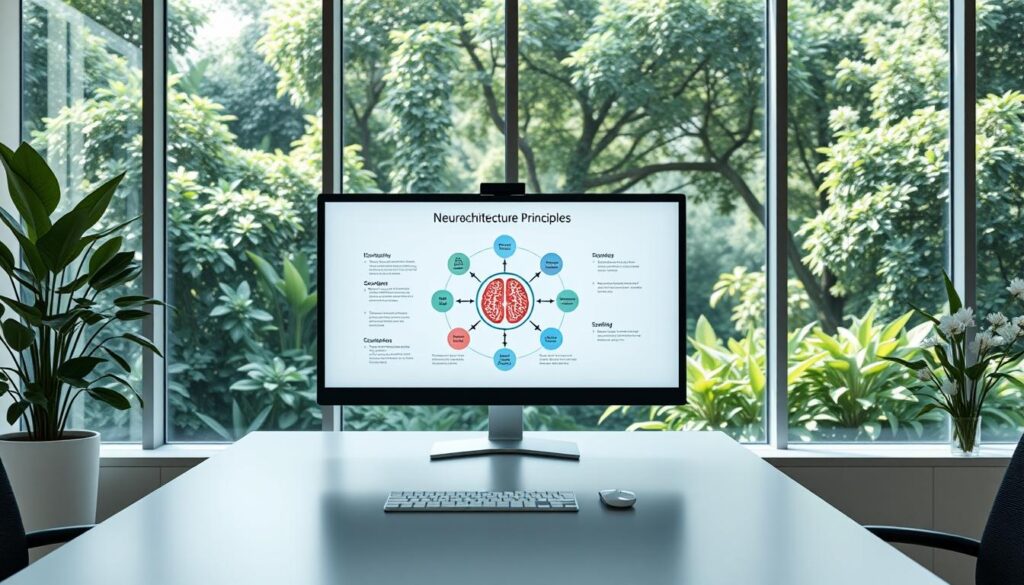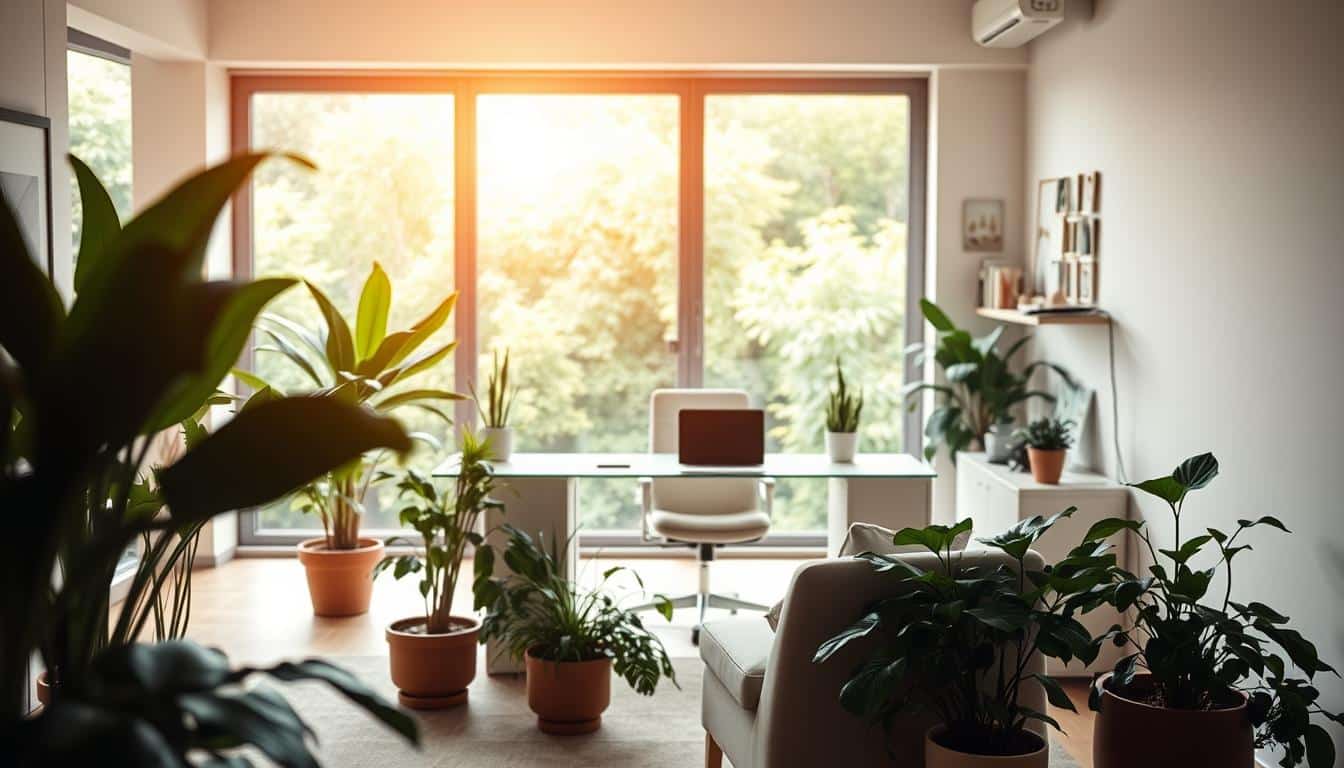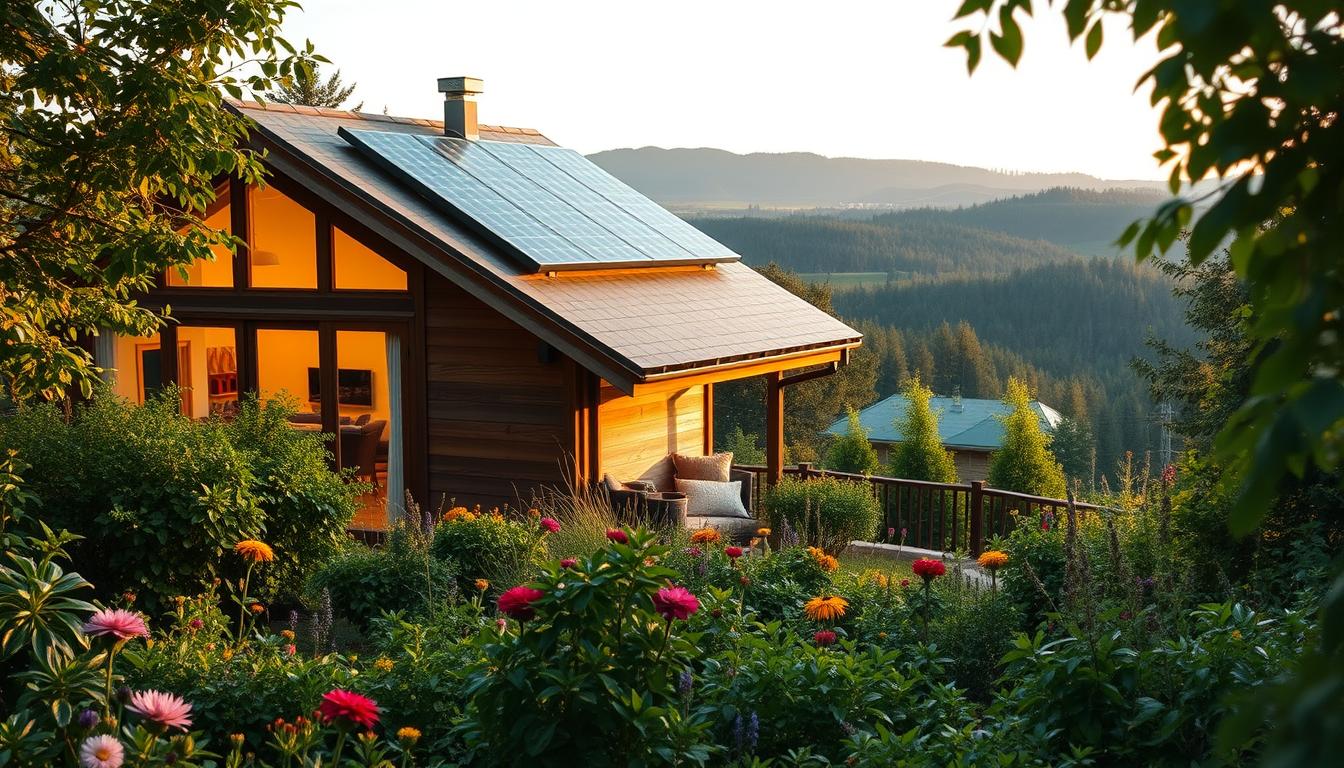The fast world of work today is being shaped by the insights of neuroarchitecture. This cutting-edge field combines brain science with building design. It shows us that our surroundings can deeply affect our thinking and well-being. By using a biophilic approach, adding natural elements like plants, offices become not just prettier but healthier and more inviting places to work.
This piece dives into how greenery can transform office spaces. It focuses on the positive impact on creativity and happiness at work. Understanding the blend of neuroarchitecture and nature leads to workspaces that care about the well-being and satisfaction of employees.
Understanding Neuroarchitecture: Merging Design and Neuroscience
Neuroarchitecture is a groundbreaking fusion of architecture and neuroscience. It explores how our surroundings impact our brains and happiness. This area delves into how design elements can change our actions and feelings.
Definition and Importance
Neuroarchitecture shows how buildings affect our thoughts, feelings, and actions. Using neuroscience, designers can make spaces that boost comfort and welcome everyone. This is crucial for all, especially for those with different neurological needs and the elderly. It shows how smart design can improve happiness.
How Neuroarchitecture Influences Human Behavior
Certain design features, like lighting, color, and layout, can influence our behavior significantly. Studies show that good design can improve thinking and emotions. This leads to better working and interacting spaces.
By understanding the emotional effects of space, we can create healthier workplaces. These places encourage teamwork and ensure people feel good. So, neuroarchitecture is both an idea and a guide for better design.

The Role of Natural Elements in Office Design
Adding natural elements to office design brings big benefits. Plants make workspaces lively and more beautiful while improving health. They do more than just look good. They boost how well employees work and feel.
Benefits of Incorporating Plants
Plants do a great job of cleaning the air. They take away indoor pollutants, making the air healthier to breathe. Workers around plants are less stressed and can focus better. Nature in the office means a calmer, balanced place. This leads to clearer thinking and more productive days.
Impact on Mood and Productivity
Plants make people happier and more connected to their workspace. Research shows that offices with plants spark more creativity and teamwork. They create a peaceful environment. This helps employees feel more into their work and motivated. A nice work setting leads to better work and happier employees.
Neuroarchitecture Principles in Plant-Filled Offices
Biophilic design is key in neuroarchitecture. This field aims to make spaces that connect us to nature. This isn’t just for looks; it’s crucial for our mental and emotional health. By adding things like living walls and indoor gardens, offices can make workers happier and more productive.
Biophilic Design as a Core Principle
Biophilic design brings nature into workplaces. It uses natural materials and colors. Choosing real plants creates true natural experiences, making people feel more at ease and focused.
Creating a Connection with Nature
Making offices that connect with nature isn’t just about looking good. It’s about spaces that help heal and inspire creativity. Adding plants, natural light, and natural shapes can make a workplace calm. These touches lower stress and make our brains work better, helping everyone do their best. Neuroarchitecture uses these ideas to design workplaces that truly connect with nature.
The Influence of Natural Light on Workplace Well-being
Natural light is key to a better office setting. It keeps our body clocks in check, lifting our spirits and energy. Having enough natural light can make us think clearer. This leads to being more alert and getting more done. Highlighting good lighting tricks can boost these effects.
Connection Between Light and Cognitive Performance
Studies say natural light really helps our brains work better. Offices with lots of sunlight make workers more alert and sharp. This light decreases tiredness and helps us remember things. It’s crucial for staying sharp all day. So, it’s important to design offices with natural light in mind.
Strategies for Maximizing Natural Light
There are smart ways to get more natural light in offices. Companies should think about:
- Making designs that make the most of windows and skylights.
- Using open areas to spread light all over workspaces.
- Adding fake daylight systems for when there’s not enough real sunlight.
By using these ideas, offices become happier places. This can make employees do their best. It boosts how they feel and how much they produce.
Color Psychology: Enhancing Office Ambiance
Learning about color psychology is key for a good office space. Different colors affect how we feel and work. This makes choosing the right colors for an office important. Cool colors like blue and green help calm us and focus. Warm colors like yellow can boost energy and motivation. It’s important to balance these for a workspace that supports creativity and focus.
Effects of Color on Mood and Productivity
Colors really change how we feel and work. Cool colors can calm us, making it easier to focus. Warm colors can make us excited and help us think of new ideas. Knowing this helps pick the best colors for an office. This can make everyone happier at work. Adding mood lighting with these colors makes the office even nicer. This makes a work space where people can focus better.
Implementing Color Schemes in Plant-Filled Spaces
Adding colors to spaces with plants makes them more pleasant. It also makes us feel better. For example, mixing green plants with blue can make a place more peaceful. Using preserved plant art keeps the office feeling natural. This approach makes the office look and feel better. It also helps people work better and be happier.
Creating Sensory Experiences with Textures and Materials
Adding different textures to design improves how a workspace feels. It creates a lively space that touches our senses directly. Using soft fabrics, rough stones, and smooth woods makes environments warm and welcoming.
Importance of Diverse Textures in Design
Diverse textures do more than please the eye. They change how we feel and interact with our space. By using a variety of materials, designers make spaces that spark creativity and calm. This helps make places where people enjoy spending time and feel satisfied.
Using Natural Materials in Conjunction with Plants
Combining natural materials with plants makes an office feel balanced. Wood and indoor plants together create peace. Adding moss and other botanicals increases the visual appeal, making offices more inviting. Choosing natural materials carefully improves the workplace, making it better for both seeing and feeling. This boosts happiness and work performance.
Spatial Layout: Designing for Collaborative and Private Work
The design of an office is key to mixing team areas and solo spots. A smart layout helps with teamwork and lets people work alone when needed. Finding the right mix makes the whole team more productive.
Balancing Open Areas with Quiet Zones
To make a good office space, you need a thoughtful division. Here are some ideas:
- Set aside places for group work, making sure they have what’s needed for team efforts.
- Add quiet spots in the plan, so workers have places to focus on tasks.
- Use movable walls to change up open and private spaces as necessary.
Role of Plant Installations in Defining Spaces
Plants can act as natural barriers and beautify the space. Preserved plants can:
- Help direct where people walk and mark out different areas.
- Create welcoming green spots that help build a team spirit.
- Keep areas feeling open and full of light, avoiding a boxed-in feel for quiet spaces.
Art and Personalization: Enhancing Creativity in the Workplace
Adding art to the workplace does more than just decorate. It sparks creativity, especially with nature in mind. Preserved plant installations make the space beautiful and inspire action. They energize the area. This creates a feeling of belonging for employees, which improves job happiness and motivation.
Incorporating Preserved Plant Art for Inspiration
Preserved plant art combines creativity with the peace of nature. Putting these pieces around the office helps businesses:
- Enhance aesthetic appeal, promoting a more inviting atmosphere.
- Encourage employee interactions and discussions around artistic elements.
- Create focal points that draw attention and admiration.
Encouraging Employee Personal Touches
Personalization is key in making a workplace engaging. Letting employees express their style with art or personal pieces builds a connection. A creative vibe can be nurtured by:
- Encouraging team members to bring in their own artwork or decorations.
- Designating areas for rotating displays of personal or team-created art.
- Providing opportunities for collaborative art projects, particularly with preserved plant materials.
Soundscapes and Acoustic Controls for a Productive Environment
Creating a productive space means smartly managing sound. Noise pollution can mess with our focus and slow down work. By using natural elements like plants, companies can keep noise low. These green friends help soak up sound, making a quiet, focus-friendly place.
Reducing Noise Pollution with Natural Elements
Plants make the office look good and keep it quiet. They help cut down on loud sounds from outside activities. The main perks are:
- Plants’ leaves can catch noise, making the place quieter.
- Greenery has a soothing effect, making us feel better.
- They make the office pretty and manage noise at the same time.
Acoustic Management Strategies in Plant-Filled Offices
For better sound control in offices with plants, we can try different things:
- Use furniture and designs that soak up sound to stop echoes.
- Make quiet areas where people can work without noise interruptions.
- Put up walls or sections with plants to block more noise.
By adding these sound control ways to the calming effect of plants, businesses can make work more productive and enjoyable for everyone.
Conclusion
Using neuroarchitecture in plant-filled offices shows how design affects our minds, feelings, and well-being. This idea uses our deep knowledge of how surroundings impact us. It combines nature with smart design. Offices become lively places with green plants, colors, and textures. This helps make teams feel better mentally and emotionally.
Biophilic design is key to boosting creativity and productivity. Employees in these environments are happier and more focused. They do better at work. With a layout that offers both team and solo spaces, plant-filled offices meet various working styles. They also make the work atmosphere better.
Companies now see how important employee well-being is. Neuroarchitecture will help shape future offices. They will connect us to nature and use new design ideas. This makes workspaces look good and work well. It helps everyone do their best.



